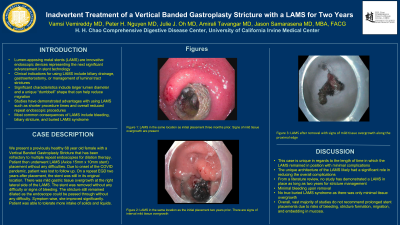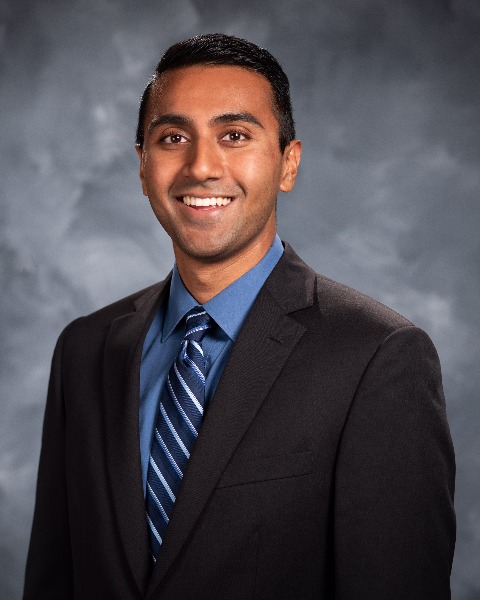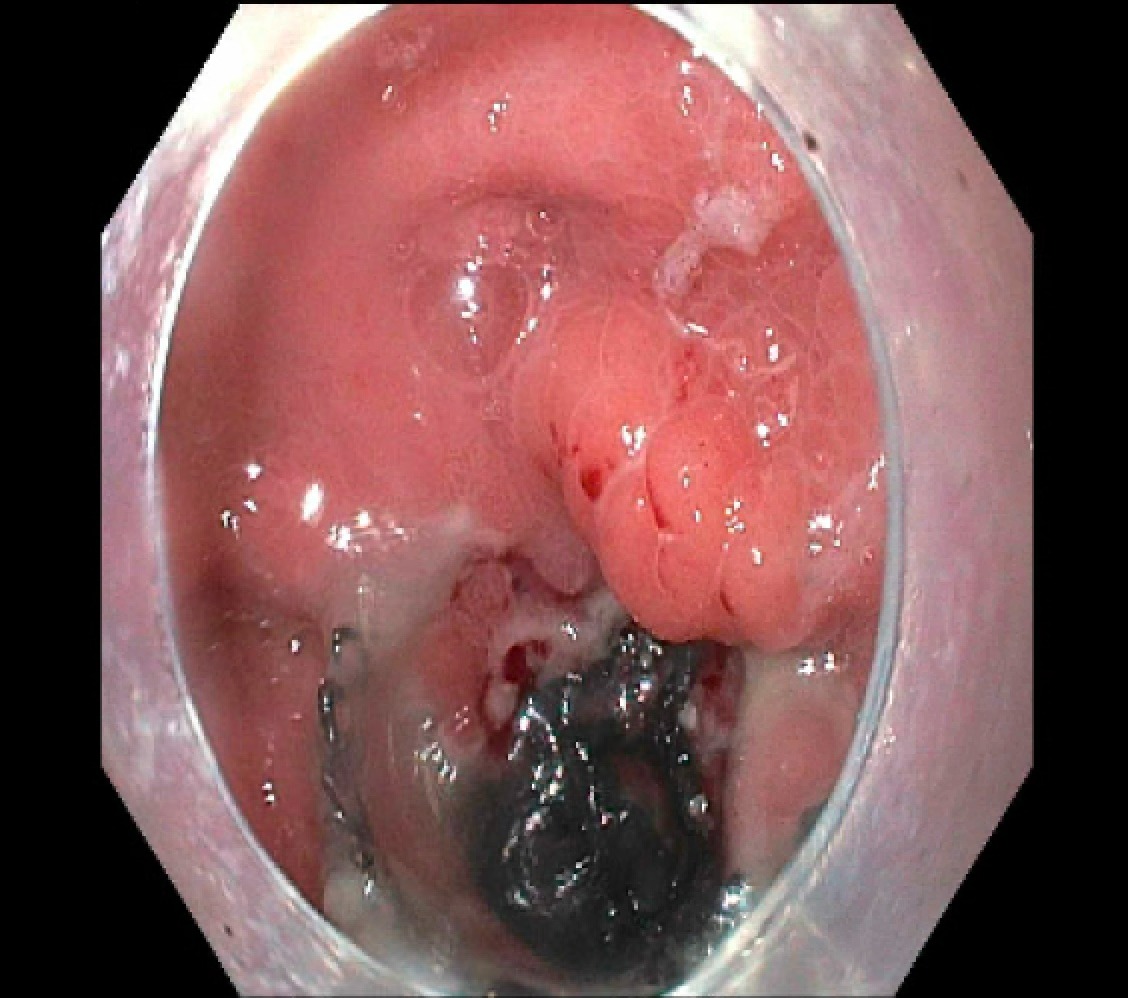Back

Poster Session C - Monday Afternoon
Category: Interventional Endoscopy
C0480 - Inadvertent Treatment of a Vertical Banded Gastroplasty Stricture With a LAMS for Two Years
Monday, October 24, 2022
3:00 PM – 5:00 PM ET
Location: Crown Ballroom


Vamsi Vemireddy, MD
University of California Irvine
Orange, CA
Presenting Author(s)
Vamsi Vemireddy, MD1, Peter H. Nguyen, MD2, Julie J. Oh, MD1, Amirali Tavangar, MD1, Jason Samarasena, MD, MBA, FACG3
1University of California Irvine, Orange, CA; 2University of California, Irvine, Orange, CA; 3UC Irvine, Orange, CA
Introduction: Lumen-apposing metal stents (LAMS) are innovative endoscopic devices representing the next significant advancement in stent technology. LAMS have demonstrated success, most notably with improving drainage of pancreatic fluid collections. Other clinical indications for using LAMS include biliary drainage, gastroenterostomy, or the managment of luminal tract strictures. The stent has a larger lumen diameter than previously created stents as well as a unique “dumbbell” shape to limit migration. Studies have demonstrated advantages such as shorter procedure times and overall reduced repeat endoscopic procedures. As LAMS has gained notoriety, there have been increasing studies demonstrating potential complications of the device. Most common consequences of LAMS include bleeding, biliary stricture, and buried LAMS syndrome. As the anatomical design has decreased migration risk, prompt removal is recommended to prevent buried LAMS syndrome, where the stent is embedded in the wall of the gastric mucosa and can eventually not be visualized endoscopically. In this case, we will present a patient with an endoscopically placed LAMS, which was successfully removed with minimal complications after two years in place.
Case Description/Methods: Our patient is a 68 year old female with a Vertical Banded Gastroplasty Stricture. She had required multiple repeat endoscopies for dilation therapy but the stricture was refractory to dilation, as a result, she underwent LAMS placement Due to the onset of the COVID pandemic, patient was lost to follow up. On a repeat EGD two years after placement, the stent remained in its original location. There were signs of mild gastric tissue overgrowth at the right lateral side of the LAMS. The stent was then removed easily with no signs of bleeding. After removal, the stricture remained dilated as the scope could be passed without difficulty. Over course of COVID she ate better than she had in years.
Discussion: LAMS have demonstrated significant success in a variety of endoscopic interventions. Their potential complications are well documented in various studies. This case is unique in regards to the length of time in which the LAMS remained in position. From a literature review, no study has demonstrated a LAMS in place as long as two years for stricture management. More remarkable is the lack of complications from the stent such as no bleeding with removal and no true buried LAMS syndrome as there was minimal tissue overgrowth.

Disclosures:
Vamsi Vemireddy, MD1, Peter H. Nguyen, MD2, Julie J. Oh, MD1, Amirali Tavangar, MD1, Jason Samarasena, MD, MBA, FACG3. C0480 - Inadvertent Treatment of a Vertical Banded Gastroplasty Stricture With a LAMS for Two Years, ACG 2022 Annual Scientific Meeting Abstracts. Charlotte, NC: American College of Gastroenterology.
1University of California Irvine, Orange, CA; 2University of California, Irvine, Orange, CA; 3UC Irvine, Orange, CA
Introduction: Lumen-apposing metal stents (LAMS) are innovative endoscopic devices representing the next significant advancement in stent technology. LAMS have demonstrated success, most notably with improving drainage of pancreatic fluid collections. Other clinical indications for using LAMS include biliary drainage, gastroenterostomy, or the managment of luminal tract strictures. The stent has a larger lumen diameter than previously created stents as well as a unique “dumbbell” shape to limit migration. Studies have demonstrated advantages such as shorter procedure times and overall reduced repeat endoscopic procedures. As LAMS has gained notoriety, there have been increasing studies demonstrating potential complications of the device. Most common consequences of LAMS include bleeding, biliary stricture, and buried LAMS syndrome. As the anatomical design has decreased migration risk, prompt removal is recommended to prevent buried LAMS syndrome, where the stent is embedded in the wall of the gastric mucosa and can eventually not be visualized endoscopically. In this case, we will present a patient with an endoscopically placed LAMS, which was successfully removed with minimal complications after two years in place.
Case Description/Methods: Our patient is a 68 year old female with a Vertical Banded Gastroplasty Stricture. She had required multiple repeat endoscopies for dilation therapy but the stricture was refractory to dilation, as a result, she underwent LAMS placement Due to the onset of the COVID pandemic, patient was lost to follow up. On a repeat EGD two years after placement, the stent remained in its original location. There were signs of mild gastric tissue overgrowth at the right lateral side of the LAMS. The stent was then removed easily with no signs of bleeding. After removal, the stricture remained dilated as the scope could be passed without difficulty. Over course of COVID she ate better than she had in years.
Discussion: LAMS have demonstrated significant success in a variety of endoscopic interventions. Their potential complications are well documented in various studies. This case is unique in regards to the length of time in which the LAMS remained in position. From a literature review, no study has demonstrated a LAMS in place as long as two years for stricture management. More remarkable is the lack of complications from the stent such as no bleeding with removal and no true buried LAMS syndrome as there was minimal tissue overgrowth.

Figure: LAMS on endoscopic evaluation two years after placement
Disclosures:
Vamsi Vemireddy indicated no relevant financial relationships.
Peter Nguyen indicated no relevant financial relationships.
Julie Oh indicated no relevant financial relationships.
Amirali Tavangar indicated no relevant financial relationships.
Jason Samarasena: Conmed – Consultant. Docbot – Stock Options. Mauna Kea – Consultant. Olympus – Consultant. Ovesco – Consultant. Steris – Consultant.
Vamsi Vemireddy, MD1, Peter H. Nguyen, MD2, Julie J. Oh, MD1, Amirali Tavangar, MD1, Jason Samarasena, MD, MBA, FACG3. C0480 - Inadvertent Treatment of a Vertical Banded Gastroplasty Stricture With a LAMS for Two Years, ACG 2022 Annual Scientific Meeting Abstracts. Charlotte, NC: American College of Gastroenterology.
